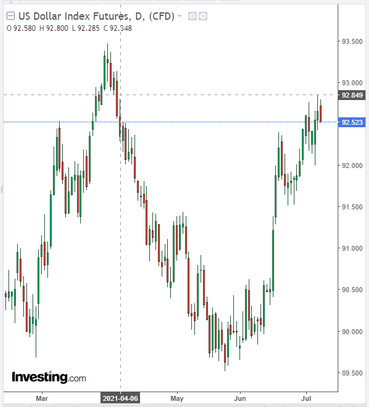The American Petroleum Institute (API) reported on Wednesday that crude oil inventories in the United States fell by -8.0 million barrels last week. Gasoline inventories fell by -2.7 million barrels. The dollar also weakened during today's Asian session after the publication on the eve of the minutes from the June Fed meeting.
Nevertheless, on this seemingly positive information for oil prices, they have been falling since the opening of today's trading day, moreover, for the third trading day in a row.
As of this writing, WTI crude oil futures are traded near 71.58 mark, after hitting a local intraday low of 70.80.
Oil prices fell as uncertainty about the prospects for global supply caused by the deadlock in the OPEC+ talks continue to affect energy markets, oil market analysts say.
The cartel and its allies were unable to come to an agreement on the volume of oil production. Disagreements persist between Saudi Arabia and the UAE. Saudi Arabia, Russia and other members of the alliance are in favor of increasing oil production, but the UAE has blocked these plans.
If the alliance does not increase production, oil prices could rise to $ 80 a barrel. But,
fears about the consequences of persisting disagreements within OPEC+, as well as the accelerating spread of the coronavirus in Asia, have negatively impacted oil prices. So, South Korea reported on the eve of the highest level of infections in the history of the pandemic, and Japan, which is in 4th place in terms of oil consumption in the world, intends to declare a state of emergency in the Tokyo region by August 22 amid a new wave of growth in the incidence. Also, everyone remembers well the recent surge in the incidence of coronavirus in India. Developed countries are the main consumers of "black gold", so the introduction of a lockdown will reduce the global demand for fuel.
Meanwhile, the US dollar received a new impetus for sales after the publication of the minutes of the FRS meeting, which again indicated a wait-and-see attitude on the issue of curtailing the stimulating policy.
DXY futures are traded near 92.52 as of this writing, 32 pips below yesterday's and 3-month highs.

Fed officials expect inflation to gradually return to the 2% target. They continue to view the rise in inflation as only a "temporary phenomenon". Recovery of the labor market remains more important for them than inflation indicators, and it is still far from full employment.
Returning to the oil market, we note that today volatility in oil prices may increase again, when the weekly data on oil and oil products from the US Department of Energy will be published at 15:00 (GMT).
Commercial oil reserves in the country are expected to fall by -4.033 million barrels after falling by -6.718, -7.614, -7.355, -5.241, -5.08 million barrels in previous reporting periods.
This is a positive factor for prices, which should rise, given also the weakening dollar and disagreements in OPEC over changes in production volumes. However, we see the opposite picture. Oil prices are falling, accompanied by a fall in the stock market.
At the same time, the prices for gold, which is actively in demand during periods of uncertainty, are growing.
Uncertainty and concerns about the accelerating spread of the coronavirus seem to be returning to the markets, implying new lockdowns and a slowdown in business activity.
However, it is also premature to talk about the reversal of the bullish trend prevailing in the oil and commodity markets.
In case of a breakdown of the support level of 71.12, the price of WTI crude oil may decline to the support level of 69.70 (see Technical analysis and trading recommendations). But this is so far only a correction after active growth in the previous 13 months.





